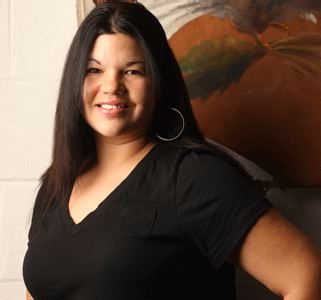Ashley Minner, a community-based visual artist, counts among the 55,000 members of the Lumbee Tribe of North Carolina.
Born and raised in Baltimore where she still lives, Minner has been active in the city’s Lumbee community, regularly visiting communities throughout the U.S and in South and Latin America.
“Baltimore has the largest Lumbee community outside of North Carolina. We’re mostly in East Baltimore and the historic community [that is] now called ‘Upper Fells Point.’ Our church and the Indian Center, and some Lumbee people are still there in the neighborhood,” said Minner.
Minner works as a folklorist for the Maryland Traditions Program of the Maryland State Arts Council and is a part-time lecturer in the Department of American Studies at UMBC. She is also part-time faculty member in the Masters of Fine Arts in Community Arts Program at MICA.
“A lot of [Lumbee] people have moved out to places like Dundalk, Essex and Rosedale. I would say we’re pretty insular, in some ways… but in a diverse, urban place like Baltimore, we live, work and play with all kinds of people. We can be friendly and welcoming or not, just like anyone else,” she said.
In 2016, Minner invited Museum Studies graduate students from the University of Maryland to visit the Lumbee Indian community of East Baltimore.
Their visit included a first attempt at a walking tour of sites important to our people in the neighborhood where Lumbee first settled.
In the case of the Lumbee community of East Baltimore, there aren’t a lot of written records to be found. Many places have changed owners, inhabitants and purpose, while some have been demolished and built over— literally and deliberately erased— so that there is no building left to visit, nothing left to see, according to Minner.
Following World War II, Lumbee Indians from rural North Carolina moved to Baltimore in droves, forming a satellite community in the Southeast quadrant of town, with numbers eventually reaching into the thousands.
America’s process of nation building has been one of inclusion and exclusion. Ideas about who does and doesn’t belong here are ever-contested and ever-changing with the political, economic, and social tides of history, Minner said, alluding to a series she and friend and photographer Sean Scheidt have been working on, in which elders get to share their stories.
The “Point of Entry” project focuses on local seniors. Minner says it’s a poignant way to disrupt hateful rhetoric about immigrants.
“It grew out of a few other projects we did and it’s an ethnographic project that focuses on elder immigrants to Baltimore. So far, we’ve worked with people from Germany, Italy, Greece, India, Vietnam and Eritrea,” Minner said.
“Sean takes these beautiful portraits of our subjects and I do interviews with them. We feel that at this time, it’s important to showcase the faces and voices of people who came from elsewhere, but have helped to build this city,” she said. “It’s hard to hate someone after you know their story and our focus on elders really complicates ideas that many people have about immigrants today.”
In Minner’s artist statement, she says she is most inspired by the beauty of everyday people.
“All of my work is what you call “narrative” in art speak. It always tells a story and I believe that the experiences of everyday people are both wonderful and important,” she said. “And, that everyone is an expert in their own life. I try to let that shine through all of what I make, which ranges from drawing, painting, printmaking, fiber, artists books, installation, and to more media.”
Minner continues to work on various projects and says she is probably most proud of the one she did with the Baltimore Museum of Industry in 2011 titled “Hard Workin’ Pilgrims: Lumbee Indians in Baltimore City Industry.”
“The featured elders … got dressed up and came to the museum,” she said. “Not only did they get to see their life stories being honored in a major cultural institution, they got to speak for themselves. It was beautiful.”
